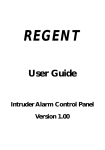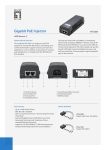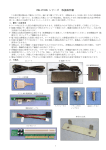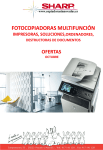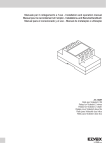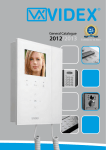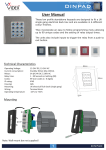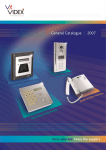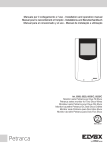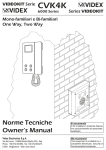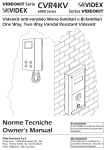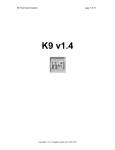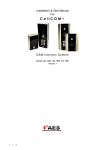Download Product Manual
Transcript
Edition 2009 Rev. 1.6 Index INDEX ........................................................................................................................................................................... 3 ART.4333 ...................................................................................................................................................................... 4 SPEAKER UNIT WITH BUILT-IN CAMERA ..........................................................................................................................................................................................4 ART.125 ........................................................................................................................................................................ 6 CALL EXPANSION MODULE ............................................................................................................................................................................................................6 ART.3181 ...................................................................................................................................................................... 7 DIGITAL INTERCOM FOR VX2300 2 WIRE SYSTEM..........................................................................................................................................................................7 ART.3381 ...................................................................................................................................................................... 9 DIGITAL VIDEOPHONE FOR VX2300 2 WIRE SYSTEM ......................................................................................................................................................................9 ART.5488 .................................................................................................................................................................... 12 HANDS FREE VIDEOMONITOR FOR VX2300 .................................................................................................................................................................................12 ART.5188 .................................................................................................................................................................... 16 HANDS FREE INTERCOM FOR VX2300.........................................................................................................................................................................................16 ART.317 ...................................................................................................................................................................... 20 FOUR WAY DISTRIBUTION BOX .....................................................................................................................................................................................................20 ART.318 ...................................................................................................................................................................... 21 TWO WAY PASSIVE DISTRIBUTION BOX .........................................................................................................................................................................................21 ART.2315 .................................................................................................................................................................... 22 BUS BOOSTER AND VIDEO SIGNAL AMPLIFIER..............................................................................................................................................................................22 ART.2301N.................................................................................................................................................................. 23 ENTRANCES EXCHANGER FOR VX2300 DIGITAL SYSTEMS ............................................................................................................................................................23 ART.2305 .................................................................................................................................................................... 24 EXTENSION RELAY FOR VX2300 DIGITAL SYSTEMS .....................................................................................................................................................................24 ART.2380 .................................................................................................................................................................... 25 INTERFACE “2 WIRE” TO “4+1” AUDIO SYSTEM ...........................................................................................................................................................................25 ART.2321-2321/P ........................................................................................................................................................ 27 POWER SUPPLIES FOR VX2300...................................................................................................................................................................................................27 ART.2322 .................................................................................................................................................................... 28 POWER SUPPLY CONVERTER FROM BUS LINE TO 12 VDC ............................................................................................................................................................28 GENERAL DIRECTIONS FOR INSTALLATION ............................................................................................................ 29 Two Wire Videokit ESVK Series Art.4333 Speaker unit with built-in camera Fig.1 Fig.2 DESCRIPTION Speaker unit module with built-in B&W camera with autoiris lens comprised of IR illumination LEDs. According to the speaker unit version it includes one or two call push buttons. The module is available also in colour camera version where the illumination LEDs are white light. The unit circuitry incorporates : The transmitting amplifier with condenser microphone and volume control; The receiving amplifier with volume control; The audio balance circuit with the “BALANCE” control; The enslavement relay to enable the electric lock (3 contacts: common, normally open and normally closed). It can work also as capacitor discharge to supply directly the electric lock; The call buttons from 1 to a maximum of 2 depending on the module version; The illumination LEDs for the card name holder; The camera comprised of illumination LEDs. Module Details: a. Camera with illumination LEDs; b. Loudspeaker; c. Card name holder; d. Call push button (1 or 2 according to the model); e. Operation LEDs f. Microphone; g. Microphone volume control; h. Balance Control; i. Loudspeaker volume control; j. Dip-switch to carry out the following programming: - Door station ID (switches from 1 to 3); - Door opening time (switch 4); - Conversation time (switch 5); k. System connection terminals; AVAILABLE MODULE VERSIONS Art.4333-1, 4333-1/color Art.4333-1D, 4333-1D/color Art.4333-1, 4333-1/color Art.4333-1D, 4333-1D/color BUTTONS LAYOUT PrtCode:ESVK_ENG_1.6.doc – Pag.4/44 25/11/2009 Rev.1.6 Two Wire Videokit ESVK Series FRONT LEDS SIGNALLING DESCRIPTION Sign Description When illuminated, indicates that it is not possible to make a call because a call or a conversation is in progress (from the outdoor station from which you are calling or from another outdoor station on systems with multiple entrances). The LED will be off when the system is in stand-by If illuminated, indicates that the call from the outdoor station is in progress. The LED will switch OFF when the call is answered or after the programmed number of rings. If illuminated, indicates that it is possible to speak because the call has been answered. The LED will switch OFF at the end of a conversation (or at the end of the conversation time). If illuminated, indicates that the door lock has been operated. It will switch OFF at the end of the programmed “door opening” time. PROGRAMMING The programming consists of the following settings: - Unit ID (1..8); - Door Opening Time (3 or 6 seconds); - Conversation Time (1 or 2 minutes); The settings are carried out trough the 6 way dip-switch (reference j on figure 2) accessible from the rear side of the module. The switch 6 is not used. Door Opening Time Unit ID 1 OFF ON OFF ON OFF ON OFF ON Switches 2 3 OFF OFF OFF OFF ON OFF ON OFF OFF ON OFF ON ON ON ON ON ID 1 2 3 4 5 6 7 8 Switches 4 OFF ON SIGNALS ON SYSTEM CONNECTION TERMINALS Terminal Description BUS Bus connection terminals BUS PTE “Push to exit” active low input GND Ground Seconds 3 6 Conversation Time Switches 5 OFF ON Minutes 1 2 Terminal NO C +C Description Door open relay normally open contact Door open relay normally closed contact Electric lock capacitor discharge output 35Vdc power supply input (if used, the module is powered VAUX locally and not from the BUS) GND Ground NC Door open relay normally closed contact To use the electric lock with capacitor discharge, make a short between “C” and “+C” then connect the electric lock between terminals “NO” and “GND”. UNIT SPECIFICATION Housing/Mounting Push Buttons Programming Controls Front plate Finishes Power Supply Working Temperature One 4000 Series Module / 4000 Series Modular System Yes, from 0 to 2 call buttons according to the model Yes, carried out by the 6 way dip-switch located on the rear of the module Microphone and Loudspeaker volume trimmers plus balance trimmer Mirror stainless steel (standard) and Anodized aluminium (add /a after the product code) Supplied by the BUS line -10 +50ºC CUSTOMER SUPPORT INFORMATION All Countries Customers VIDEX Electronics S.p.A. www.videx.it – [email protected] Tel.+39 0734 631669 Fax +39 0734 632475 UK Customers VIDEX Security LTD www.videx-security.com Tech Line 0191 224 3174 Fax 0191 224 1559 The product is CE marked demonstrating its conformity and is for distribution within all member states of the EU with no restrictions. This product follows the provisions of the European Directives 89/336/EEC & 92/31/EEC (EMC), 73/23/EEC (LVD) and 93/68/EEC (CE marking). PrtCode:ESVK_ENG_1.6.doc – Pag.5/44 25/11/2009 Il prodotto è marchiato CE a dimostrazione della sua conformità e può essere distribuito liberamente all’interno dei paesi membri dell’unione europea EU. Questo prodotto è conforme alle direttive Europee 89/336/EEC & 92/31/EEC (EMC), 73/23/EEC (LVD) e 93/68/EEC (Marcatura CE). Rev.1.6 Two Wire Videokit ESVK Series Art.125 Call expansion module Fig.1 DESCRIPTION This module must be used in combination with speaker units Art.4333 with firmware release 2.0 or higher. The module, in combination with standard 4000 series button expansion modules (Art.4842, 4843, 4844 and 4845), allows to add up to 5 call buttons to the call buttons built-in the speaker unit to reach a maximum of 7 call buttons. To supply the LED of the button expansion modules make the connection as shown in figure 1. UNIT SPECIFICATION Housing/Mounting Push Buttons Programming Controls Power Supply Working Temperature 5 resistors module / fix to button expansion module N/A N/A N/A N/A -10 +50ºC CUSTOMER SUPPORT INFORMATION All Countries Customers VIDEX Electronics S.p.A. www.videx.it – [email protected] Tel.+39 0734 631669 Fax +39 0734 632475 UK Customers VIDEX Security LTD www.videx-security.com Tech Line 0191 224 3174 Fax 0191 224 1559 The product is CE marked demonstrating its conformity and is for distribution within all member states of the EU with no restrictions. This product follows the provisions of the European Directives 89/336/EEC & 92/31/EEC (EMC), 73/23/EEC (LVD) and 93/68/EEC (CE marking). PrtCode:ESVK_ENG_1.6.doc – Pag.6/44 25/11/2009 Il prodotto è marchiato CE a dimostrazione della sua conformità e può essere distribuito liberamente all’interno dei paesi membri dell’unione europea EU. Questo prodotto è conforme alle direttive Europee 89/336/EEC & 92/31/EEC (EMC), 73/23/EEC (LVD) e 93/68/EEC (Marcatura CE). Rev.1.6 Two Wire Videokit ESVK Series Art.3181 Digital intercom for VX2300 2 Wire System Fig.1 Fig.2 DESCRIPTION Intelligent intercom with “door open/intercommunicating call” push button (key), bus relay (Art.2305) activation button (dot), “privacy ON-OFF” switch, “door open” and “privacy on” LEDs and call tone volume control (3 levels). To reduce bus current all apartment devices are in a sleep mode when not used. In case a user forgot to replace the handset, each operation must be executed within 10 seconds of lifting the handset otherwise the handset returns to its sleep state. To then perform an operation it would be necessary to hang up the handset and pick it up again. PUSH BUTTONS, LEDS AND CONTROLS (FIG.1) a Door open push button – Intercommunicating call. For an intercommunicating call, pick up the handset and press as many times as the extension or address value to call (see SW3 Intercommunication Settings). b Activate bus relay board Art.2305 push button. To activate a bus relay pick up the handset and press as many times as the address value of the relay. c Door Open LED. Switched ON if the door is open. Its operation depends on additional connections. d Privacy ON LED. Switched ON when the privacy service is active e Privacy ON-OFF switch. The privacy duration time can be programmed. If the intercom is programmed for a specific privacy duration, after the service is enabled to “ON” (red LED ON), the service will automatically turn off when the time expires. f Call tone volume control (3 levels) DIP-SWITCHES AND JUMPERS (FIG.2) SW1 Switches from 1 to 7 are used for unit address (from 1 to 127 binary coded). Last switch (8) is not used SW2 Switches 1,2 and 3 are used to set privacy duration time. Switch 4 is not used. SW3 Switches 1,2 and 3 are used to for intercommunication settings. Switch 4 is not used. S1 Impedance terminator. The jumper must be normally closed. When more videophones/intercoms are connected in parallel (from a peripheral to another and so on until the last) the jumper must be open for all the intercoms except for the last following the connection order. PROGRAMMING After each programming operation carried out through dip-switches or jumpers it is necessary to temporary disconnect the phone from the BUS or from the power supply if locally powered. SW1 – INTERCOM ADDRESS Switches Status 7 6 5 4 3 OFF OFF OFF OFF OFF OFF OFF OFF OFF OFF OFF OFF OFF OFF OFF OFF OFF OFF OFF ON 2 OFF ON ON OFF 1 ON OFF ON OFF 64 0 0 0 0 32 0 0 0 0 OFF OFF ON 0 1 ON OFF OFF ON Binary Code – Decimal Value 16 8 4 0 0 0 0 0 0 0 0 0 0 0 1 0 0 1 2 0 1 1 0 1 1 0 1 0 Decimal Code 1 2 3 4 0 1 37 ON ON OFF OFF OFF ON ON 1 1 0 0 0 1 1 99 The table above shows how to set the address of the phone. Considering that ON = 1 and OFF = 0, multiply each digit for the relevant decimal weight then add values obtained to get the address: E.g. as highlighted in the table OFF,ON,OFF,OFF,ON, OFF,ON in binary is equal to 0100101 then adding each digit for the relevant decimal weight you obtain the address 37. Note The maximum number of units allowed is 100 but the address of each unit can be a value between 1 and 127 PrtCode:ESVK_ENG_1.6.doc – Pag.7/44 25/11/2009 Rev.1.6 Two Wire Videokit ESVK Series SW2 – PRIVACY DURATION TIME Switches Status 4 3 2 1 OFF OFF OFF ON OFF ON OFF ON ON ON Privacy Mode (switch 1) The privacy duration time is set by switches 2 and 3. When enabled the privacy service will be disabled when the set time expires or the switch is moved back to off. No privacy time expiration: the privacy service is enabled or disabled only by the slide switch. SW3 – INTERCOMMUNICATION SETTINGS Switches Status 4 3 2 Privacy Duration (switches 2,3) 15 minutes 1 hour 4 hours 8 hours 1 Videophone Extension (switches 2,3) 1 (master) Intercommunication Mode (switch 1) Intercommunication allowed between videophones (same unit address) inside the same flat. To call an extension pick up the handset then press the “door open” button OFF ON as many times as the extension value (Eg. extension 2 two times, 3 three times etc). 2 (slave) Each intercom/videophone in the same apartment must have a different exten- 3 (slave) ON OFF OFF sion address, the master address must always be set except when one of the intercom/videophone is set for apartment intercommunication (i.e. in a 3 interON ON com/videophone installation, one of the intercom/videophone must have the 4 (slave) extension address 1 while the others must have different addresses) Intercommunication allowed between videophones (different apartment). To call an OFF OFF ON extension pick up the handset then press the “door open” button as many times as the address value (Eg. extension 10 ten times, 12 twelve times etc) On installations where there are more than one intercom/videophone in the same apartment and intercommunication between different apartments is required, only one intercom/videophone may be set with this function (SW3.1=ON, SW3.2=OFF, SW3.3=OFF). The other intercom/videophones in the apartment must be set for local intercommunication with extension addresses “2-4” (slaves). From the intercom/videophone set for intercommunication with other apartments it will be not possible to intercommunicate within the apartment but slave extensions 2-4 will be able to intercommunicate with each other. OFF OFF NUMBER OF RINGS The number of rings can be set to 3 (factory preset) or 6. To change the number of rings proceed as follow: - Disconnect the power supply from the system; - Short the terminals “LB” and “GND”; - Reconnect the power supply to the system checking the privacy on LED and then remove the short between terminals “LB” and “GND”; - The number of LED flashes will be 1 for 3 rings or 2 for 6 rings. Each time this operation is carried out the number of rings is switched between the values 3 and 6. SIGNALS ON CONNECTION TERMINALS Signal Description BUS Bus contacts BUS LEDDoor open LED ground signal input LED+ Door open LED power supply input (+12Vdc) GND Ground signal GND Ground signal AL Alarm input (not implemented) LB Local Bell contact (put a push button between this terminal and the relevant GND terminal) SPECIFICATION Housing/Mounting Push Buttons Programming Controls Power Supply Working Temperature 3000 Series Intercoms / direct wall mounting Yes, two Yes, carried out by the dip-switches inside the intercom Call tone volume and privacy ON-OFF switch Supplied by the BUS line -10 +50ºC CUSTOMER SUPPORT INFORMATION All Countries Customers VIDEX Electronics S.p.A. www.videx.it – [email protected] Tel.+39 0734 631669 Fax +39 0734 632475 UK Customers VIDEX Security LTD www.videx-security.com Tech Line 0191 224 3174 Fax 0191 224 1559 The product is CE marked demonstrating its conformity and is for distribution within all member states of the EU with no restrictions. This product follows the provisions of the European Directives 89/336/EEC & 92/31/EEC (EMC), 73/23/EEC (LVD) and 93/68/EEC (CE marking). PrtCode:ESVK_ENG_1.6.doc – Pag.8/44 25/11/2009 Il prodotto è marchiato CE a dimostrazione della sua conformità e può essere distribuito liberamente all’interno dei paesi membri dell’unione europea EU. Questo prodotto è conforme alle direttive Europee 89/336/EEC & 92/31/EEC (EMC), 73/23/EEC (LVD) e 93/68/EEC (Marcatura CE). Rev.1.6 Two Wire Videokit ESVK Series Art.3381 Digital videophone for VX2300 2 Wire System Fig.1 Fig.2 DESCRIPTION Intelligent videophone with 4” flat screen B&W monitor with “door open” and “camera recall” push buttons, bus relay enable button, service button, “privacy ON-OFF” button plus “privacy on” and “door open” LEDs. Controls: 3 levels of call tone volume (both main and local) plus contrast and brightness. The videophone is available also in colour version Art.3481 which uses a 3,5” active matrix LCD monitor. To reduce bus current all apartment devices are in a sleep mode when not used. In case a user forgot to replace the handset, each operation must be executed within 10 seconds of lifting the handset otherwise the handset returns to its sleep state. To then perform an operation it would be necessary to hang up the handset and pick it upagain. PUSH BUTTONS, LEDS AND CONTROLS (FIG.1) a Door open push button – Intercommunicating call. For an intercommunicating call, pick up the handset and press as many times as the extension or address value to call (see SW3 Intercommunication Settings). b Camera recall push button. Pick up the handset and press as many times as the DEVICE N. of the door station to switch on. If the door station uses the Art.4303N plus the Art.4330N, pressing this button during a conversation switches the video signal coming from the camera module to the video signal coming from the camera module input for external camera. c Activate bus relay board Art.2305 push button. To activate a bus relay pick up the handset and press as many times as the address value of the relay. d Service push button. e Privacy ON-OFF push button. The privacy duration time can be programmed. f Privacy ON LED. Switched ON when the privacy service is active. g Door Open LED. Switched ON if the door is open. Its correct operation depend from correct connection (terminals 1 and 18) h Call tone volume control (3 levels) i Contrast control (left decrease, right increase) l Brightness control (left decrease, right increase) DIP-SWITCHES AND SWITCHES (FIG.2) SW1 Switches from 1 to 7 are used for unit address (from 1 to 127 binary coded). Last switch (8) is not used SW2 Switches 1,2 and 3 are used to set privacy duration time. Switch 4 is not used. SW3 Switches 1,2 and 3 are used for intercommunication settings. Switch 4 is used to set the slave mode. SW Impedance terminator. The standard position is “close”. When more videophones are connected in parallel (from a videophone to another and so on until the last) it must be set to “open” for all the videophones except for the last following the connection order. PrtCode:ESVK_ENG_1.6.doc – Pag.9/44 25/11/2009 Rev.1.6 Two Wire Videokit ESVK Series PROGRAMMING After each programming operation carried out through dip-switches or jumpers it is necessary to temporary disconnect the videophone from the BUS or from the power supply if locally powered. NUMBER OF RINGS The number of rings can be set to 3 (factory preset) or 6. To change the number of rings proceed as follow: - Unplug the flat cable from the pcb connection board; - Put in short the terminals 13 and 14; - Plug-in the flat cable checking the privacy on LED and remove the short between terminals 13 and 14; - The number of LED flashes will be 1 for 3 rings or 2 for 6 rings. Each time this operation is carried out the number of rings is switched between the values 3 and 6. SW1 – VIDEOPHONE ADDRESS Switches Status 7 6 5 4 3 OFF OFF OFF OFF OFF OFF OFF OFF OFF OFF OFF OFF OFF OFF OFF OFF OFF OFF OFF ON 2 OFF ON ON OFF 1 ON OFF ON OFF 64 0 0 0 0 32 0 0 0 0 OFF ON OFF OFF ON OFF ON 0 1 0 0 1 0 1 37 ON ON OFF OFF OFF ON ON 1 1 0 0 0 1 1 99 Binary Code – Decimal Weight 16 8 4 2 0 0 0 0 0 0 0 1 0 0 0 1 0 0 1 0 1 1 0 1 0 Address 1 2 3 4 The table above shows how to set the address of the videophone. Considering that ON = 1 and OFF = 0, multiply each digit for the relevant decimal weight then sum values obtained to get the address: E.g. as highlighted in the table OFF,ON,OFF,OFF,ON, OFF,ON in binary is equal to 0100101 then multiplying each digit for the relevant decimal weight you obtain the address that is 37. Note The maximum number of units allowed is 100 but the address of each unit can be a value between 1 and 127. SW2 – PRIVACY DURATION TIME Privacy Mode (switch 1) Switches Status 4 3 OFF OFF ON ON 2 OFF ON OFF ON 1 OFF ON The privacy duration time is set by switches 2 and 3. When enabled the privacy service is disable when the time set expires or the relevant button is pressed again. 3 2 1 15 minutes 1 hour 4 hours 8 hours No privacy time expiration: the privacy service is enabled or disabled only by the privacy button. SW3 – INTERCOMMUNICATION SETTINGS Switches Status 4 Privacy Duration (switches 2,3) Intercommunication Mode (switch 1) Videophone Extension (switches 2,3) 1 (Master) Intercommunication between videophones in the same apartment. To call an extension pick up the handset then press the “door open” button as many times as the exOFF ON tension (Eg. extension 2 two times, 3 three times etc). Each intercom/videophone 2 (Slave) OFF must have a different extension address, the master address must always be 3 (Slave) ON OFF set (i.e. in a 3 intercom/videophone installation, one of the intercom/videophone must have the extension address 1 while the others must 4 (Slave) ON ON have different addresses included from 2 to 4) Intercommunication between videophones in different apartments. To call an extenOFF OFF ON sion pick up the handset then press the “door open” button as many times as the address (Eg. extension 10 ten times, 12 twelve times etc) Slave Mode (switch 4) for Extensions 2, 3 and 4 OFF Factory preset, during a call the slave videophones will only ring while the master will also show the video picture). The picture will only appear on the slave when answered. ON During a call, the videophone will ring and show the video picture: in this case the videophone must be powered locally using an Art.2321 and connecting BUS+ to “Vin” (9) and BUS- to “–“ (10). NOTE: Extension 1 is mandatory. On systems with more than one device in an apartment, each device must have a unique extension ID. OFF OFF On installations where there are more than one intercom/videophone in the same apartment and intercommunication between different apartments is required, only one intercom/videophone may be set with this function (SW3.1=ON, SW3.2=OFF, SW3.3=OFF). The other intercom/videophones in the apartment must be set for local intercommunication with extension addresses “2-4” (slaves). From the intercom/videophone set for intercommunication with other apartments it will be not possible to intercommunicate within the apartment but slave extensions 2-4 will be able to intercommunicate with each other. PrtCode:ESVK_ENG_1.6.doc – Pag.10/44 25/11/2009 Rev.1.6 Two Wire Videokit ESVK Series VIDEOPHONE CONNECTION BOARD ART.3980 As 3000 series videophones also this version uses the Art.3980 connection board. Fig.3 SIGNALS ON TERMINALS OF ART.3980 CONNECTION BOARD Terminal Signal Description 1 -LD Door open LED ground signal input 2 AL Alarm input (not implemented) 3 S Contacts for “S” service push button. Linked together when the button is pressed 4 S 5 GND Ground signal 6 7 8 9 Vin Auxiliary power supply input (for local power supply) 10 11 BUS Bus contacts 12 BUS 13 Local bell contacts 14 LB 15 16 17 18 +LD Door open LED power supply (12Vdc) SPECIFICATION Housing/Mounting Push buttons Programming Controls Power Supply Working Temperature 3000 Series Videophones / mounting plate plus connection board Yes, 5 Yes, carried out by the dip-switches located on the rear of the videophone Call tone volume, contrast and brightness Supplied by the BUS line -10 +50 ºC CUSTOMER SUPPORT INFORMATION All Countries Customers VIDEX Electronics S.p.A. www.videx.it – [email protected] Tel.+39 0734 631669 Fax +39 0734 632475 UK Customers VIDEX Security LTD www.videx-security.com Tech Line 0191 224 3174 Fax 0191 224 1559 The product is CE marked demonstrating its conformity and is for distribution within all member states of the EU with no restrictions. This product follows the provisions of the European Directives 89/336/EEC & 92/31/EEC (EMC), 73/23/EEC (LVD) and 93/68/EEC (CE marking). PrtCode:ESVK_ENG_1.6.doc – Pag.11/44 25/11/2009 Il prodotto è marchiato CE a dimostrazione della sua conformità e può essere distribuito liberamente all’interno dei paesi membri dell’unione europea EU. Questo prodotto è conforme alle direttive Europee 89/336/EEC & 92/31/EEC (EMC), 73/23/EEC (LVD) e 93/68/EEC (Marcatura CE). Rev.1.6 Two Wire Videokit ESVK Series Hands Free Videomonitor for VX2300 164 Art.5488 3 2 4 53 1 130,00 Fig.1 Fig.2 DESCRIPTION An intelligent Hands-free (surface or flush mounting) video monitor employing a colour 3.5” active matrix LCD display, with push buttons for “door open/intercommunicating call”, “answer/camera recall”, “privacy on/off”, “BUS relay activation” and 2 service buttons plus 4 LED’s associated with 4 main buttons. In addition to the above the unit has controls for loudspeaker volume, call tone volume, brightness and hue with programmable number of rings, privacy duration and intercommunication mode. PUSH BUTTONS, LEDS AND CONTROLS (FIG.1) Service push button - When pressed, shorts terminal “S1” to terminal “GND” (ground). Bus Relay Button to Activate bus relay board Art.2305. To activate a bus relay press as many times as the address value of the relay. Answer button - On an incoming call, operation of this button allows the user to answer and converse with the visitor. LED 2 will illuminate. Camera recall button - Press as many times as the DEVICE N. of the door station to switch on. Switch off button - With the system switched on (monitor on), momentary operation of the button will switch the video monitor off. The videomonitor will also automatically switch off after a time delay if the button is not pressed. LED 2 will switch off. Simplex button - Pressing and holding the button for more than 3 seconds will switch the videomonitor into SIMPLEX speech mode. Press and hold the button to speak to the caller (LED 2 will flash rapidly), release the button to listen (LED 2 will flash slowly). If the button is not pressed for 10 seconds the videomonitor will switch off. The videomonitor will revert to duplex speech when another call is made. When pressed, shorts terminal “S2” to Terminal “GND” (ground). Privacy on-off button: − If the monitor is switched on, press and keep pressed this button for more than 3 seconds to enable/disable the service. The relative LED will illuminate when the privacy service is enabled. until the privacy LED switches ON. − If the monitor is switched off, keep this button pressed together with the “speak” button Camera select button - With a conversation in progress, press to switch from door station camera to external camera (requires Art.4330N and external camera) and viceversa. Intercommunicating call button - For an intercommunicating call, when the videomonitor is in stand-by, press as many times as the extension or address value to call. Door open button - During a call, operation of this button will activate the “door open” relay (NO1, NC1, COM1). LED 4 will illuminate if terminal 6 has been connected to a door contact. 1 LED for programming purposes 2 LED relating to the operation of the answer/switch off/camera recall/simplex button 3 LED relating to the operation of privacy button 4 LED relating to the operation of door open button(powered from the connection terminal “6” of Art.5980) Loudspeaker volume control Call tone volume control Brightness control Colour intensity control PrtCode:ESVK_ENG_1.6.doc – Pag.12/44 25/11/2009 Rev.1.6 Two Wire Videokit ESVK Series PROGRAMMING The videomonitor setup consists of the following settings: - Number of Rings; - Melody selection; - Unit address (1..127, switches 1 to 7 of SW1); - Bus Termination (open or close, switch 8 of SW1); - Intercommunication mode (between apartments or within apartment switch 1 of SW3); - Extension address (1..4, switches 2,3 of SW3); - Slave mode (switch 4 of SW3); - Privacy duration (switches 1,2 and 3 of SW2) The programming of the number of rings and melody are carried out through the videomonitor push buttons , all other settings are carried out on the three dip-switch banks (SW1, SW2 and SW3) on the rear side of the video monitor. Except the number of rings programming, it is necessary to remove temporary the power supply after making any other programming changes. NUMBER OF RINGS AND MELODY SELECTION First of all make a camera recall to switch on the unit then proceed with the programming operation.To alter the number of rings and select the melody, the videomonitor must be in program mode. This is achieved by operating the two following buttons at the same time (left button of the volume control and the right button of the colour intensity control) see Fig.1A 8 small buttons towards the bottom of the face plate (far left button and far right button together). When the programming mode is entered LED 1 (Fig.1A) starts flashing. This will automatically reset after 20 seconds of idle time. Number of rings − When in the programming mode press and hold the “ ” button, LED 1 will stop flashing and LED 3 (Fig.1A) will start to flash showing the number of rings (each flash = 1 ring i.e. 6 flashes = 6 rings) − Once the value of rings has been reached release the “ ” button. − Wait approx 10 seconds for LED 1 to stop flashing to signal that the new value is stored and program mode has exited. Melody selection − When in the programming mode, press left or right call tone volume control buttons (press the left button to navigate backward or the right button to navigate forward in the melodies selection menù) until the videomonitor plays the selected melody (during the melody play the LED1 stops flashing); − Before press again one of the two buttons to select previous (left button) or next (right button) melody, wait for LED1 starts flashing again then press and hold pressed one button until the selected melody is played; − Once reached the required melody, Wait approx 10 seconds for LED 1 to stop flashing to signal that the new value is stored and program mode has exited. Notes The second melody increases its volume at each ring: first ring starts at minimum volume level up to the maximum volume level on the last ring. Are available 4 levels of volume: if are set 6 rings, the fourth, the fifth and the sixth will be emitted at the maximum volume level. VIDEOMONITOR ADDRESS – SW1.1..7 The table above shows how to set the address of the videophone. Considering that ON = 1 and OFF = 0, multiply each digit for the relevant decimal weight then sum values obtained to get the address: E.g. as highlighted in the table OFF,ON,OFF,OFF,ON, OFF,ON in binary is equal to 0100101 then multiplying each digit for the relevant decimal weight you obtain the address that is 37. Switches Status 4 3 OFF OFF OFF OFF OFF OFF OFF ON 7 OFF OFF OFF OFF 6 OFF OFF OFF OFF 5 OFF OFF OFF OFF OFF ON OFF OFF ON ON ON ON Binary Code – Decimal Weight 16 8 4 2 0 0 0 0 0 0 0 1 0 0 0 1 0 0 1 0 2 OFF ON ON OFF 1 ON OFF ON OFF 64 0 0 0 0 32 0 0 0 0 ON OFF ON 0 1 0 0 1 ON ON ON 1 1 1 1 1 Address 1 1 0 1 0 1 2 3 4 0 1 37 1 1 127 Note The maximum number of units allowed is 100 but the address of each unit can be a value between 1 and 127. BUS TERMINATION - SW1.8 The factory preset for this switch is ON: termination enabled. In case of more units (intercoms, videophones or video monitors) in a parallel connection (bus wires are connected to the terminals of the first unit then from this to the second and so on up to 4 units max) switch 8 must be set to ON only for the last unit in the chain while on all other units must be set to OFF (bus termination disabled). INTERCOMMUNICATION MODE – SW3.1 This switch establishes the intercommunication mode: in OFF position (default) intercommunication is between units in the same apartment (same addresses but different extension); in ON position the intercommunication is between units in different apartments (different addresses). On installations where there are more than one intercom/videophone in the same apartment and intercommunication between different apartments is required, only one intercom/videophone may be set with this function (SW3.1=ON, SW3.2=OFF, SW3.3=OFF). The other intercom/videophones in the apartment must be set for local intercommunication with extension addresses “2-4” (slaves). From the intercom/videophone set for intercommunication with other apartments it will be not possible to intercommunicate within the apartment but slave extensions 2-4 will be able to intercommunicate with each other. PrtCode:ESVK_ENG_1.6.doc – Pag.13/44 25/11/2009 Rev.1.6 Two Wire Videokit ESVK Series EXTENSION NO – SW3.2..3 If the intercommunication between apartments is enabled (switch 1 of SW3 = ON) leave these two switches in default position (both to OFF). Otherwise, if the intercommunication is between the same apartment (switch 1 of SW3 = OFF), set the extension addresses starting always from 1. During the external call, all video monitors in the same flat will ring but the video will be shown only from the videmononitor with extension address 1. 2 3 Extension No. OFF OFF 1 (default, master) ON OFF 2 (slave) OFF ON 3 (slave) ON ON 4 (slave) SLAVE MODE - SW3.4 This set up concerns the answering mode of the video monitor when there is more than one unit (max 4) in the same apartment. OFF (default) = during a call, only the video monitor with extension 1 (master) will show the video. ON = the video monitor will be switched on independently of the extension address: in this case the video monitor must be supplied locally using a power supply Art.2321 and connecting respectively BUS+ to terminal 14 and BUS- to terminal 11 of the pcb connection board provided with the Art.5980. PRIVACY UNLIMITED – SW2.1 If this switch is set to OFF (default), the privacy duration is defined by switches 2 and 3.If this switch is set to ON, the privacy duration is unlimited and the service can be enabled or disabled only by the privacy button. PRIVACY DURATION – SW2.2..3 This set up requires that switch 1 is set to OFF. 2 3 Duration OFF OFF 15 minutes ON OFF 1 hour OFF ON 4 hours ON ON 8 hours VIDEOMONITOR CONNECTION BOARD ART.5980 Fig.3 SIGNAL ON CONNECTION TERMINALS Terminal 1 2 3 4 5 6 7 8 9 10 11 12 13 14 15 16 17 18 19 20 Signal GND BUS1 Ground Bus input BUS2 S1 LED S2 GND GND LB GND Bus input Terminal controlled by the S1 button, close to GND until the button is pressed Auxiliary LED power supply input (12Vdc) Terminal controlled by the S2 button, close to GND until the button is pressed Ground Ground Local bell input (active low) Ground +VAUX AL Description Auxiliary power supply input (to be used when the switch 4 of SW3 is set to ON) Alarm input (not implemented yet) PrtCode:ESVK_ENG_1.6.doc – Pag.14/44 25/11/2009 Rev.1.6 Two Wire Videokit ESVK Series VIDEOMONITOR WALL MOUNTING INSTRUCTIONS Fig.1 Fig.2 Fig.3 Fig.4 - Cables must be fed through the opening “e” (Fig. 2A) of the mounting plate “c”, which should be fitted approximately 135cm from finished floor level as shown in Fig 1; - Place the mounting plate “c” against the wall feeding the wire group “d” through opening “e” of the mounting plate and mark the fixing holes “a” (Fig. 2A) - Drill the fixing holes “a”, insert the wall plugs “b” then with the cables threaded through opening “e” fix the mounting plate “c” to the wall with the 4 screws provided “f” (Fig. 2A). - Hook the pcb connection board “g” to the mounting plate “c”as shown in Fig2B and connect the wires (using the screwdriver provided) to the terminals as shown in the diagram provided; - Once the wires are connected, hook the videophone “h” to the Mounting plate “c” as shown in Fig. 3. • Connect the Plug “I” on the ribbon cable from the videophone to the plug “l” on the PCB connection board “g”; • Place the videophone “h” against the 4 hooks “m” on the mounting plate “c” (in line with the 4 openings “n” on the rear side of the videophone Fig. 4) and push down as suggested by the pointers in Fig. 3, the videophone will lock into place; - To remove the videophone, hold it firmly and push the unit in an upward direction until the videophone “h” unlocks from the mounting plate “c”. SPECIFICATION Housing/Mounting Push buttons Programming Controls Power Supply Working Temperature 5000 Series Videophones / mounting plate plus connection board Yes, 6 Yes, carried out by the dip-switches located on the rear of the videophone Loudspeake and call tone volume, brightness and hue Supplied by the BUS line -10 +50 ºC CUSTOMER SUPPORT INFORMATION All Countries Customers VIDEX Electronics S.p.A. www.videx.it – [email protected] Tel.+39 0734 631669 Fax +39 0734 632475 UK Customers VIDEX Security LTD www.videx-security.com Tech Line 0191 224 3174 Fax 0191 224 1559 The product is CE marked demonstrating its conformity and is for distribution within all member states of the EU with no restrictions. This product follows the provisions of the European Directives 89/336/EEC & 92/31/EEC (EMC), 73/23/EEC (LVD) and 93/68/EEC (CE marking). PrtCode:ESVK_ENG_1.6.doc – Pag.15/44 25/11/2009 Il prodotto è marchiato CE a dimostrazione della sua conformità e può essere distribuito liberamente all’interno dei paesi membri dell’unione europea EU. Questo prodotto è conforme alle direttive Europee 89/336/EEC & 92/31/EEC (EMC), 73/23/EEC (LVD) e 93/68/EEC (Marcatura CE). Rev.1.6 Two Wire Videokit ESVK Series Art.5188 Hands Free Intercom for VX2300 74,00 23,50 A 1 3 2 4 164,00 ON 1 2 3 4 SW3 B JP1 24,50 SW1 1 2 3 4 5 6 7 8 ON Fig.1 DESCRIPTION PUSH BUTTONS, LEDS AND CONTROLS (FIG.1) Bus Relay Button to Activate bus relay board Art.2305. To activate a bus relay press as many times as the address value of the relay. Answer button - On an incoming call, operation of this button allows the user to answer and converse with the visitor. LED 2 will illuminate. Camera recall button - Press as many times as the DEVICE N. of the door station to switch on. Switch off button - With the system switched on, momentary operation of the button will switch the unit off. The intercom will also automatically switch off after a time delay if the button is not pressed. LED 2 will switch off. Simplex button - Pressing and holding the button for more than 3 seconds will switch the intercom into SIMPLEX speech mode. Press and hold the button to speak to the caller (LED 2 will flash rapidly), release the button to listen (LED 2 will flash slowly). If the button is not pressed for 10 seconds the intercom will switch off. The intercom will revert to duplex speech when another call is made. Privacy on-off button: − If the unit is switched on, press and keep pressed this button for more than 3 seconds to enable/disable the service. The relative LED will illuminate when the privacy service is enabled. until the privacy LED switches ON. − If the unit is switched off, keep this button pressed together with the “speak” button Intercommunicating call button - For an intercommunicating call, when the intercom is in stand-by, press as many times as the extension or address value to call. Door open button - During a call, operation of this button will activate the “door open” relay (NO1, NC1, COM1). LED 4 will illuminate if terminal 6 has been connected to a door contact. 1 Programming LED 2 LED relating to the operation of the answer/switch off/camera recall/simplex button 3 LED relating to the operation of privacy button 4 LED relating to the operation of door open button(powered from the connection terminal “2” & GND "1" on the connection board) Loudspeaker volume control Call tone volume control PROGRAMMING The intercom setup consists of the following settings: - Number of Rings; - Privacy duration; - Melody selection; - Unit address (1..127, switches 1 to 7 of SW1); - Intercommunication mode (between apartments or within apartment switch 1 of SW3); - Extension address (1..4, switches 2,3 of SW3); - Bus Termination (JP1 jumper on connection board); PrtCode:ESVK_ENG_1.6.doc – Pag.16/44 25/11/2009 Rev.1.6 Two Wire Videokit ESVK Series The programming of the number of rings, melody and privacy duration are carried out through the intercom push buttons , all other settings are carried out on the two dip-switch banks (SW1 and SW3) on the rear side of the video monitor. The BUS termination depends on the position of JP1 on the connection board. Except for when programming the number of rings, it is necessary to temporarily remove the power supply from the unit after making programming changes. NUMBER OF RINGS, PRIVACY DURATION AND MELODY SELECTION First of all make a recall to switch on the unit then proceed with the programming operation. To alter the number of rings and select the melody, the intercom must be in program mode. This is achieved by pressing the two following buttons at the same time (left button of the volume control and the right button of the call tone volume control) see Fig.1.When the programming mode is entered LED 1 (Fig.1) starts flashing. This will automatically reset after 20 seconds of idle time. Number of rings − When in the programming mode press and hold the “ ” button, LED 1 will stop flashing and LED 3 (Fig.1) will start to flash showing the number of rings (each flash = 1 ring i.e. 6 flashes = 6 rings) − Once the value of rings has been reached release the “ ” button. − Wait approx 10 seconds for LED 1 to stop flashing to signal that the new value is stored and program mode has exited. Privacy duration − When in the programming mode press and hold the “ ” button, LED 1 will stop flashing and LED 3 (Fig.1) will start to flash showing the number of times the button is pressed (each flash = 15 minutes i.e. 8 flashes = 2 hours ) − Once the duration required has been reached release the “ ” button. − Wait approx 10 seconds for LED 1 to stop flashing to signal that the new value is stored and program mode has exited. Melody selection (press the left button to navigate backward or the right button − When in the programming mode, press left or right call tone volume control buttons to navigate forward through the melodies selection menù) After each press, the melody will be played (during the melody play the LED1 stops flashing); − Before pressing again one of the two buttons to select previous (left button) or next (right button) melody, wait for LED1 to start flashing again then press and hold one button until the selected melody is played; − Once the required melody is reached, Wait approx 10 seconds for LED 1 to stop flashing to signal that the new value is stored and program mode has exited. Notes The second melody increases its volume at each ring: first ring starts at minimum volume level and adjusts up to the maximum volume level on the last ring. There are 4 volume levels: Rings after this will all play at full volume. INTERCOM ADDRESS – SW1.1..7 The table above shows how to set the address of the videophone. Considering that ON = 1 and OFF = 0, multiply each digit for the relevant decimal weight then add values obtained to get the address: E.g. as highlighted in the table OFF,ON,OFF,OFF,ON, OFF,ON in binary is equal to 0100101 then multiplying each digit for the relevant decimal weight you obtain the address that is 37. Switches Status 4 3 OFF OFF OFF OFF OFF OFF OFF ON 7 OFF OFF OFF OFF 6 OFF OFF OFF OFF 5 OFF OFF OFF OFF OFF ON OFF OFF ON ON ON ON Binary Code – Decimal Weight 16 8 4 2 0 0 0 0 0 0 0 1 0 0 0 1 0 0 1 0 2 OFF ON ON OFF 1 ON OFF ON OFF 64 0 0 0 0 32 0 0 0 0 ON OFF ON 0 1 0 0 1 ON ON ON 1 1 1 1 1 Address 1 1 0 1 0 1 2 3 4 0 1 37 1 1 127 Note The maximum number of units allowed is 100 but the address of each unit can be a value between 1 and 127. Set switch 8 to OFF position. INTERCOMMUNICATION MODE – SW3.1 This switch establishes the intercommunication mode: in OFF position (default) intercommunication is between units in the same apartment (same addresses but different extension); in ON position the intercommunication is between units in different apartments (different addresses). On installations where there are more than one intercom/videophone in the same apartment and intercommunication between different apartments is required, only one intercom/videophone may be set with this function (SW3.1=ON, SW3.2=OFF, SW3.3=OFF). The other intercom/videophones in the apartment must be set for local intercommunication with extension addresses “2-4” (slaves). From the intercom/videophone set for intercommunication with other apartments it will be not possible to intercommunicate within the apartment but slave extensions 2-4 will be able to intercommunicate with each other. EXTENSION NO – SW3.2..3 If the intercommunication between apartments is enabled (switch 1 of SW3 = ON) leave these two switches in default position (both to OFF). Otherwise, if the intercommunication is between the same apartment (switch 1 of SW3 = OFF), set the extension addresses starting always from 1. 2 3 Extension No. OFF OFF 1 (default, master) ON OFF 2 (slave) OFF ON 3 (slave) ON ON 4 (slave) Notes: Set switch “4” to OFF position. PrtCode:ESVK_ENG_1.6.doc – Pag.17/44 25/11/2009 Rev.1.6 Two Wire Videokit ESVK Series BUS LINE TERMINATION JP1 The factory preset for this jumper is “A” position: termination enabled. In case of more units (intercoms, videophones or video monitors) in a parallel connection (bus wires are connected to the terminals of the first unit then from this to the second and so on up to 4 units max) JP1 must be set to A position only for the last unit in the chain while on all other units must be set to B position (bus termination disabled). In case of units of different type, videophones, video monitor, hands free or standard intercoms etc. remains fixed the rule that the bus termination must be enabled only on the last unit in order of connection. INTERCOM CONNECTION BOARD 1 2 3 4 5 6 7 8 9 10 A B JP1 Fig.2 SIGNAL ON CONNECTION TERMINALS Terminal 1 2 3 4 5 6 7 8 9 10 Signal GND LED LB AL Description Ground Auxiliary LED +12Vdc Input Local bell active low input Alarm input (not implemented yet) BUS2 Bus input BUS1 Bus input PrtCode:ESVK_ENG_1.6.doc – Pag.18/44 25/11/2009 Rev.1.6 Two Wire Videokit ESVK Series ART.5188 INTERCOM WALL MOUNTING INSTRUCTIONS a 135cm b A B Fig.1 Fig.2 Fig.3 A g e c h d B Fig.4 Fig.5 Fig.6 − As shown in Fig 1, looking at the rear of the intercom, insert the tip of a flat blade screwdriver into one of the two openings (Fig 1A) then slightly move the screwdriver in an upward direction to release the front from the back plate and opening the intercom unit (Fig 1B).Take care! The back plate of the intercom houses the pcb connection board which is normally connected to the pcb in the front of the intercom by the ribbon cable, the ribbon cable should not be connected when first opened. − Place the back plate of the intercom against the wall at approximately 135cm (Fig 2) above finished floor level, then mark the fixing holes taking into account that the cable group “a” must feed into the opening “b” (Fig 3). − As shown in figure 3, fix the back plate of the intercom to the wall feeding the cable group “a” through opening “b”. − Using a flat blade screwdriver connect the wires to the pcb connection board “c” as shown in Figure 4, according to the installation diagram provided. − Connect ribbon cable plug “d” from the front plate into plug “e” on the pcb connection board as shown in Figure 5. − Close the intercom by hooking the front plate “g” to the back plate “h” as described below: Hook the top of the front plate “g” to the top of the back plate as shown by pointer “A” in Figure 6. Move the lower side of the front plate “g” towards the back plate“h” and press until the unit locks into the back plate of the intercom. To open the intercom once installed, firmly grasp the bottom sides of the front plate cover, pull forward in an upward direction to separate the front cover from the back plate as in Figure 6. NB. Please take care when opening to avoid damage, remember that the ribbon cable connects the front plate to the back plate connector pcb. SPECIFICATION Housing/Mounting Push buttons Programming Controls Power Supply Working Temperature 5000 Series Intercoms / direct wall mount Yes, 4 Yes, carried out by the dip-switches located on the rear of the videophone Loudspeaker and call tone volume Supplied by the BUS line -10 +50 ºC CUSTOMER SUPPORT INFORMATION All Countries Customers VIDEX Electronics S.p.A. www.videx.it – [email protected] Tel.+39 0734 631669 Fax +39 0734 632475 UK Customers VIDEX Security LTD www.videx-security.com Tech Line 0191 224 3174 Fax 0191 224 1559 The product is CE marked demonstrating its conformity and is for distribution within all member states of the EU with no restrictions. This product follows the provisions of the European Directives 89/336/EEC & 92/31/EEC (EMC), 73/23/EEC (LVD) and 93/68/EEC (CE marking). PrtCode:ESVK_ENG_1.6.doc – Pag.19/44 25/11/2009 Il prodotto è marchiato CE a dimostrazione della sua conformità e può essere distribuito liberamente all’interno dei paesi membri dell’unione europea EU. Questo prodotto è conforme alle direttive Europee 89/336/EEC & 92/31/EEC (EMC), 73/23/EEC (LVD) e 93/68/EEC (Marcatura CE). Rev.1.6 Two Wire Videokit ESVK Series Art.317 Four way distribution box Fig.1 Fig.2 DESCRIPTION The unit distributes the bus signal to 4 outputs linked to videophones or intercoms. The distributor has 3 amplification levels (low, medium and high), the amplification only effects the 4 outputs and not the loop through output. The Art.317 also includes a bus isolation feature which isolates the Art.317 from the rest of the bus if there is a short on one of its outputs. This prevents a short in any one apartment compromising the whole system. CONNECTION TERMINALS AND JUMPERS Terminal/Jumper Description BUS IN Bus input terminals BUS OUT Bus output terminals (loop through to next distributor) BUS OUT 1 Videophone/Intercom bus output 1 BUS OUT 2 Videophone/Intercom bus output 2 BUS OUT 3 Videophone/Intercom bus output 3 BUS OUT 4 Videophone/Intercom bus output 4 B1 Close/Open bus output jumper for BUS OUT 1. Move to close when BUS OUT 1 is not used. B2 Close/Open bus output jumper for BUS OUT 2. Move to close when BUS OUT 2 is not used. B3 Close/Open bus output jumper for BUS OUT 3. Move to close when BUS OUT 3 is not used. B4 Close/Open bus output jumper for BUS OUT 4. Move to close when BUS OUT 4 is not used. BL Close/Open bus through output jumper. If the distributor is the last in line move to close otherwise leave open. AMPLIFICATION Set the required level of amplification choosing between low, medium and high SPECIFICATION Housing/Mounting Push Buttons Programming Controls Power Supply Working Temperature Plastic box 70x110x30mm / direct wall mounting N/A N/A Outputs amplification (3 levels) Supplied by the BUS line -10 +50ºC CUSTOMER SUPPORT INFORMATION All Countries Customers VIDEX Electronics S.p.A. www.videx.it – [email protected] Tel.+39 0734 631669 Fax +39 0734 632475 UK Customers VIDEX Security LTD www.videx-security.com Tech Line 0191 224 3174 Fax 0191 224 1559 The product is CE marked demonstrating its conformity and is for distribution within all member states of the EU with no restrictions. This product follows the provisions of the European Directives 89/336/EEC & 92/31/EEC (EMC), 73/23/EEC (LVD) and 93/68/EEC (CE marking). PrtCode:ESVK_ENG_1.6.doc – Pag.20/44 25/11/2009 Il prodotto è marchiato CE a dimostrazione della sua conformità e può essere distribuito liberamente all’interno dei paesi membri dell’unione europea EU. Questo prodotto è conforme alle direttive Europee 89/336/EEC & 92/31/EEC (EMC), 73/23/EEC (LVD) e 93/68/EEC (Marcatura CE). Rev.1.6 Two Wire Videokit ESVK Series Art.318 Two way passive distribution box BUS BUS OUT1 OUT2 Art.318 BUS IN BUS OUT BL Close Open Fig.1 Fig.2 DESCRIPTION The unit distributes the bus signal to 2 outputs linked to videophones or intercoms. It is a passive distributor, so there is no possibility to adjust the video amplification. The device is suitable for small systems with a maximum distance between door panel and the last monitor of 70 metres. CONNECTION TERMINALS AND JUMPERS Terminal/Jumper Description BUS IN Bus input terminals BUS OUT Bus output terminals (to next distrbutor) BUS OUT 1 Videophone/Intercom bus output 1 BUS OUT 2 Videophone/Intercom bus output 2 BL Close/Open bus output jumper. If the distributor is the last move to close otherwise leave open. SPECIFICATION Housing/Mounting Push Buttons Programming Controls Power Supply Working Temperature Plastic box 50x60x20mm / direct wall mounting N/A N/A N/A Supplied by the BUS line -10 +50ºC CUSTOMER SUPPORT INFORMATION All Countries Customers VIDEX Electronics S.p.A. www.videx.it – [email protected] Tel.+39 0734 631669 Fax +39 0734 632475 UK Customers VIDEX Security LTD www.videx-security.com Tech Line 0191 224 3174 Fax 0191 224 1559 The product is CE marked demonstrating its conformity and is for distribution within all member states of the EU with no restrictions. This product follows the provisions of the European Directives 89/336/EEC & 92/31/EEC (EMC), 73/23/EEC (LVD) and 93/68/EEC (CE marking). PrtCode:ESVK_ENG_1.6.doc – Pag.21/44 25/11/2009 Il prodotto è marchiato CE a dimostrazione della sua conformità e può essere distribuito liberamente all’interno dei paesi membri dell’unione europea EU. Questo prodotto è conforme alle direttive Europee 89/336/EEC & 92/31/EEC (EMC), 73/23/EEC (LVD) e 93/68/EEC (Marcatura CE). Rev.1.6 Two Wire Videokit ESVK Series Art.2315 BUS booster and video signal amplifier BUS OUT PS H L M AMPLIFICATION BUS IN Fig.1 Fig.2 DESCRIPTION The Art.2315 restores the voltage levels of the BUS line and amplifies the video signal (3 levels: H=high, M=medium and L=low). The BUS line must be interrupted and connected to the BUS-IN input, then the signal from the BUS-OUT will be amplified. Connect to the PS input a power supply Art.2321. We suggest the use of the BUS booster in installations which are not using the VIDEX CM2 cable and it is necessary to reach large cables distances. (i.e. Using CAT5, distances greater than 70m). CONNECTION TERMINALS AND JUMPERS Terminal/Jumper Description BUS IN BUS line input BUS OUT BUS line output PS Power supply input (use Art.2321) AMPLIFICATION Video signal amplification, 3 levels = high, medium and low SPECIFICATION Housing/Mounting Push Buttons Programming Controls Power Supply Working Temperature Plastic box 50x60x20mm / direct wall mounting N/A N/A Video signal amplification (3 levels) Requires local 2321 PSU. -10 +50ºC CUSTOMER SUPPORT INFORMATION All Countries Customers VIDEX Electronics S.p.A. www.videx.it – [email protected] Tel.+39 0734 631669 Fax +39 0734 632475 UK Customers VIDEX Security LTD www.videx-security.com Tech Line 0191 224 3174 Fax 0191 224 1559 The product is CE marked demonstrating its conformity and is for distribution within all member states of the EU with no restrictions. This product follows the provisions of the European Directives 89/336/EEC & 92/31/EEC (EMC), 73/23/EEC (LVD) and 93/68/EEC (CE marking). PrtCode:ESVK_ENG_1.6.doc – Pag.22/44 25/11/2009 Il prodotto è marchiato CE a dimostrazione della sua conformità e può essere distribuito liberamente all’interno dei paesi membri dell’unione europea EU. Questo prodotto è conforme alle direttive Europee 89/336/EEC & 92/31/EEC (EMC), 73/23/EEC (LVD) e 93/68/EEC (Marcatura CE). Rev.1.6 Two Wire Videokit ESVK Series Art.2301N Entrances exchanger for VX2300 digital systems Fig.1 Fig.2 DESCRIPTION This unit is required for systems with 2 or more entrances (4 maximum). The Art.2301N has 4 inputs (IN1..IN4) each with adjustable amplification (“L” = low, “M” = medium and “H” = high) to compensate for different door station distances. The AUX input enables a second 2301N device to be connected to expand the system up to 8 entrances. When connecting 2x2301N the polarity of the bus between the Art.2301N's must be observed. When connecting 2x2301N's the BUS output of the first exchanger must be linked to the AUX input of the second exchanger and then onto the apartments. The polarities are not relevant if there is only one 2301N. The power supply inputs are PS1and PS2. The Art.2321/P with its jumper set to V2 should be used. For systems with up to 4 entrances and 50 videophones only one power supply is required connected to PS1. For larger systems connect a power supply to each of the two inputs (PS1 & PS2). When 2x2301N, the 2x2321/P power supplies only connect to the 2301N at which the AUX connection is used. (The one supplying the apartments). CONNECTION TERMINALS AND JUMPERS Terminal/Jumper Description BUSBUS Output (observe the polarities only when linked to the AUX input of a second 2301N) BUS+ AUXAuxiliary BUS input to carry out systems up to 8 entrances linking together two 2301N (observe the polarities when connecting the BUS output of the first exchanger to the AUX of the second BUS- with AUX- and BUS+ with AUX+) AUX+ IN1 Door station input 1 (the signal may be amplified by the relative jumper – L=Low, M=Medium and H=High) IN2 Door station input 2 (the signal may be amplified by the relative jumper – L=Low, M=Medium and H=High) IN3 Door station input 3 (the signal may be amplified by the relative jumper – L=Low, M=Medium and H=High) IN4 Door station input 4 (the signal may be amplified by the relative jumper – L=Low, M=Medium and H=High) PS1 Power Supply input 1 (use Art.2321/P set to V2 voltage level) PS2 Power Suppy input 2 (use Art.2321/P set to V2 voltage level) SPECIFICATION Housing/Mounting Push Buttons Programming Controls Power Supply Working Temperature 9 Module A Type DIN box / DIN Bar or directly to the wall N/A N/A Signal amplification on 3 levels for each bus input From specific power supply or from the bus -10 +50ºC CUSTOMER SUPPORT INFORMATION All Countries Customers VIDEX Electronics S.p.A. www.videx.it – [email protected] Tel.+39 0734 631669 Fax +39 0734 632475 UK Customers VIDEX Security LTD www.videx-security.com Tech Line 0191 224 3174 Fax 0191 224 1559 The product is CE marked demonstrating its conformity and is for distribution within all member states of the EU with no restrictions. This product follows the provisions of the European Directives 89/336/EEC & 92/31/EEC (EMC), 73/23/EEC (LVD) and 93/68/EEC (CE marking). PrtCode:ESVK_ENG_1.6.doc – Pag.23/44 25/11/2009 Il prodotto è marchiato CE a dimostrazione della sua conformità e può essere distribuito liberamente all’interno dei paesi membri dell’unione europea EU. Questo prodotto è conforme alle direttive Europee 89/336/EEC & 92/31/EEC (EMC), 73/23/EEC (LVD) e 93/68/EEC (Marcatura CE). Rev.1.6 Two Wire Videokit ESVK Series Art.2305 Extension Relay for VX2300 digital systems Fig.1 Fig.2 DESCRIPTION This unit can be connected directly to the bus and has two operating modes: general purpose extension relay and apartment extension relay for additional sounders. As general purpose extension relay, the built-in relays are controlled by the relevant button of the intercom or videophone while as extension sounder relay, relay one will operate on each ring and relay two will operate for the duration of the call. CONNECTION TERMINALS & DIP-SWITCHES Terminal/Jumper Description BUS Input/Output bus connection terminals BUS Input/Output bus connection terminals C2 Relay 2 common contact NO2 Relay 2 normally open contact NC2 Relay 2 normally closed contact C1 Relay 1 common contact NO1 Relay 1 normally open contact NC1 Relay 1 normally closed contact DIP-SW 8 way dip-switch to set the relay operating mode PROGRAMMING The operating mode is set by switch 8 as shown below. Note: After making changes to the dip-switch settings it is necessary to disconnect it from the bus (or power the system down) and then reconnect before the changes will take affect. GENERAL PURPOSE EXTENSION RELAY – SWITCH 8 = OFF When the unit is set as general purpose extension relay, switches 1 to 6 are used to set the relays addresses and activation times. Switches Switches Switches Relay 1,2 Relay 1 Relay 2 Addresses Time Time 1 2 3 4 5 6 OFF OFF 1,2 OFF OFF 2 seconds OFF OFF 2 seconds ON OFF 3,4 ON OFF 4 seconds ON OFF 4 seconds OFF ON 5,6 OFF ON 16 seconds OFF ON 16 seconds ON ON 7,8 ON ON 32 seconds ON ON 32 seconds Switch 7 is not used. For example if switch 1 is set to ON and switch 2 is set to OFF (addresses 3 & 4), pressing the “dot” button on the intercom (or “double dot” on the videophone) 3 times will operate relay one while pressing 4 times will operate relay two. EXTENSION SOUNDER RELAY – SWITCH 8 = ON When the unit is set in this mode, switches from 1 to 7 (8 is not used but set to on) are used to set the address of the unit: the address of the unit is set to the same address as the videophone or intercom it that apartment (refer to intercom/videophone SW1 settings). When the apartment is called, relay 1 will operate 4 times (once for each ring) while relay 2 will energise for the duration of the call (Approx. 60 seconds). The relays revert to the de-energised state if the call is cancelled or the user ends the call. SPECIFICATION Housing/Mounting Push Buttons Programming Controls Power Supply Working Temperature Dry contacts relay 5 Module A Type DIN box / DIN bar or directly to the wall N/A Yes, carried out by the 8 way dip-switch N/A from the bus -10 +50ºC Max 24Vac/dc 5A CUSTOMER SUPPORT INFORMATION All Countries Customers VIDEX Electronics S.p.A. www.videx.it – [email protected] Tel.+39 0734 631669 Fax +39 0734 632475 UK Customers VIDEX Security LTD www.videx-security.com Tech Line 0191 224 3174 Fax 0191 224 1559 The product is CE marked demonstrating its conformity and is for distribution within all member states of the EU with no restrictions. This product follows the provisions of the European Directives 89/336/EEC & 92/31/EEC (EMC), 73/23/EEC (LVD) and 93/68/EEC (CE marking). PrtCode:ESVK_ENG_1.6.doc – Pag.24/44 25/11/2009 Il prodotto è marchiato CE a dimostrazione della sua conformità e può essere distribuito liberamente all’interno dei paesi membri dell’unione europea EU. Questo prodotto è conforme alle direttive Europee 89/336/EEC & 92/31/EEC (EMC), 73/23/EEC (LVD) e 93/68/EEC (Marcatura CE). Rev.1.6 Two Wire Videokit ESVK Series Art.2380 Interface “2 Wire” to “4+1” audio system Fig.1 Fig.2 DESCRIPTION Interface to connect 4+ 1 audio devices to the VX2300 “2 Wire” Bus (For example the Art380 telephone interface or the Art275 PABX interface) Using the items listed above (380, 275) it is possible to use a conventional household telephone as a standard intercom. The operating mode of the telephone depends on the connected device and on the connections made, refer to the instructions of the Art.380 or Art275. DIP-SWITCHES AND JUMPERS (FIG.1) SW1 Switches from 1 to 7 are used for unit address (from 1 to 127 binary coded). Last switch (8) is not used SW2 Switches 1,2 and 3 are used to set privacy duration time. Switch 4 is used to set the “Priv” signal operating mode SW3 Switches 1,2 and 3 are used for intercommunication settings. Switch 4 is not used S1 Impedance terminator. The jumper must be normally closed. When more videophones/intercoms are connected in parallel (from a peripheral to another and so on until the last) the jumper must be open for all the intercoms except for the last following the order of connection. PROGRAMMING After each programming operation carried out through dip-switches or jumpers it is necessary to temporary disconnect the device the power supply if locally powered. SW1 – DEVICE ADDRESS Switches Status Binary Code – Decimal Value 7 6 5 4 3 2 1 64 32 16 8 4 2 OFF OFF OFF OFF OFF OFF ON 0 0 0 0 0 0 OFF OFF OFF OFF OFF ON OFF 0 0 0 0 0 1 OFF OFF OFF OFF OFF ON ON 0 0 0 0 0 1 OFF OFF OFF OFF ON OFF OFF 0 0 0 0 1 0 from the BUS or from 1 1 0 1 0 Decimal Code 1 2 3 4 OFF ON OFF OFF ON OFF ON 0 1 0 0 1 0 1 37 ON ON OFF OFF OFF ON ON 1 1 0 0 0 1 1 99 The table above shows how to set the address of the device. Considering that ON = 1 and OFF = 0, multiply each digit for the relevant decimal weight then sum the values obtained to get the address: E.g. as highlighted in the table OFF,ON,OFF,OFF,ON, OFF,ON in binary is equal to 0100101 then multiplying each digit for the relevant decimal weight you obtain the address that is 37. Note The maximum number of units allowed is 100 but the address of each unit can be a value between 1 and 127. SW2 – PRIVACY DURATION TIME Privacy Mode Privacy Duration Switches Status (switch 1) (switches 2,3) 4 3 2 1 The privacy duration time is set by switches 2 and 3. After the privacy service is en- 15 minutes OFF OFF abled, it is disable when the set time expires or the relevant button is pressed again. OFF ON 1 hour OFF ON OFF 4 hours ON ON 8 hours No privacy time expiration: the privacy service is enabled or disabled only by the ON relevant button. The “Priv” terminal works as an open collector output to signal the status of the privacy service. When the service is enabled the “Priv” OFF output shorts to ground. This mode must be set when the Art.2380 is connected in parallel (with the same address) to one or more interON coms/videophones. Make a link between terminals “Priv” and “2”. PrtCode:ESVK_ENG_1.6.doc – Pag.25/44 25/11/2009 Rev.1.6 Two Wire Videokit ESVK Series SW3 – INTERCOMMUNICATION SETTINGS Switches Status Intercommunication Mode (switch 1) 4 3 2 1 Intercommunication allowed between videophones (same unit address) inside the OFF OFF same flat. To call an extension pick up the handset then press the “door open” button OFF ON as many times as the extension value is (Eg. extension 2 two times, 3 three times OFF etc). If there are more videophones/intercoms connected in parallel, one at ON OFF least must be set with switches 2 and 3 to OFF ON ON Intercommunication allowed between videophones (different unit address) inside different flats. To call an extension pick up the handset then press the “door open” butOFF OFF ON ton as many times as the address value is (Eg. extension 10 ten times, 12 twelve times etc) Extension (switches 2,3) 1 2 3 4 SIGNALS ON CONNECTION TERMINALS Signal Description BUS BUS connection terminals BUS 2 Speech line in 1 Speech line out 3 Speech ground 4 Call output GND Ground 5 Active low input “door open” command A2in Auxiliary active low input 2. When active (0V) switches the status of privacy service. A1in Auxiliary active low input 1. When active (0V) the relay with address 1 of the Art.2305 if installed in the system will activate. +12Vout +12Vdc Output With SW2.4 = OFF, it works as an open collector output that signals the privacy service status. Internal link to ground when the privacy service is active. Priv With SW2.5 = ON, required setting when the Art.2380 is in a parallel (same address) connection with other devices it must be linked to terminal two. SPECIFICATION Housing/Mounting Push Buttons Programming Controls Power Supply Working Temperature 9 Module A Type DIN box N/A Yes, carried out through dip-switches N/A Supplied from the BUS -10 +50ºC CUSTOMER SUPPORT INFORMATION All Countries Customers VIDEX Electronics S.p.A. www.videx.it – [email protected] Tel.+39 0734 631669 Fax +39 0734 632475 UK Customers VIDEX Security LTD www.videx-security.com Tech Line 0191 224 3174 Fax 0191 224 1559 The product is CE marked demonstrating its conformity and is for distribution within all member states of the EU with no restrictions. This product follows the provisions of the European Directives 89/336/EEC & 92/31/EEC (EMC), 73/23/EEC (LVD) and 93/68/EEC (CE marking). PrtCode:ESVK_ENG_1.6.doc – Pag.26/44 25/11/2009 Il prodotto è marchiato CE a dimostrazione della sua conformità e può essere distribuito liberamente all’interno dei paesi membri dell’unione europea EU. Questo prodotto è conforme alle direttive Europee 89/336/EEC & 92/31/EEC (EMC), 73/23/EEC (LVD) e 93/68/EEC (Marcatura CE). Rev.1.6 Two Wire Videokit ESVK Series Art.2321-2321/P 0V 230V 105 Art.2321 Power supplies for VX2300 BUS _+ 157,5 65 Fig.1 Fig.2 DESCRIPTION These two units are specific power supplies for VX2300 digital system. The 2321 can be used for systems with 1 entrance up to 20 users while the 2321/P is for systems with more than 1 entrance and up to 100 users. CONNECTION TERMINALS AND JUMPERS Terminal/Jumper Description 0 Mains input ~230V BUS + BUS terminals BUS BUS + BUS terminals (only Art.2321/P) BUS V1 Jumper to adjust the output voltage (only Art.2321/P). V1=Low, V2=Medium, V3=Maximum. Set to maximum (V3) when the V2 unit is used together with 2301N, otherwise leave in a low or medium position V3 CONNECTION TO MAINS AND POWER SUPPLY MOUNTING INSTRACTIONS The system must be installed according to national rules in force, in particular we recommend to: - Connect the system to the mains through an all-pole circuit breaker which shall have contact separation of at least 3mm in each pole and shall disconnect all poles simultaneously; - The all-pole circuit breaker shall be placed for easy access and the switch shall remain readily operable. POWER SUPPLY INSTALLATION - Remove the terminal side covers by unscrewing the retaining screws; - Fix the power supply to a DIN bar or directly to the wall using two expansion type screws; - Switch off the mains using the circuit breaker mentioned above and then make the connections as shown on the installation diagrams; - Check the connections and secure the wires into the terminals; - Replace the terminal covers and fix them using the relevant screws; - When all connections are made, restore the mains. SPECIFICATION Housing/Mounting Push Buttons Programming Controls Power Supply Working Temperature 9 Module A Type DIN box (Art.2321) – 15 Module A Type DIN box (Art.2321/P) / DIN Bar or directly to the wall N/A N/A Voltage amplification (3 levels) 230Vac -10 +50ºC CUSTOMER SUPPORT INFORMATION All Countries Customers VIDEX Electronics S.p.A. www.videx.it – [email protected] Tel.+39 0734 631669 Fax +39 0734 632475 UK Customers VIDEX Security LTD www.videx-security.com Tech Line 0191 224 3174 Fax 0191 224 1559 The product is CE marked demonstrating its conformity and is for distribution within all member states of the EU with no restrictions. This product follows the provisions of the European Directives 89/336/EEC & 92/31/EEC (EMC), 73/23/EEC (LVD) and 93/68/EEC (CE marking). PrtCode:ESVK_ENG_1.6.doc – Pag.27/44 25/11/2009 Il prodotto è marchiato CE a dimostrazione della sua conformità e può essere distribuito liberamente all’interno dei paesi membri dell’unione europea EU. Questo prodotto è conforme alle direttive Europee 89/336/EEC & 92/31/EEC (EMC), 73/23/EEC (LVD) e 93/68/EEC (Marcatura CE). Rev.1.6 Two Wire Videokit ESVK Series Art.2322 Power supply converter from BUS line to 12 Vdc BUS Art.2322 + 12V - Fig.1 Fig.2 DESCRIPTION When this unit is connected to the BUS line it generates a +12Vdc – 100mA power source. This unit can be used to supply peripherals such as the Art.4800 without the need for an additional power supply. Please note: The peripherals must not require more than 100mA. CONNECTION TERMINALS Terminal/Jumper Description BUS BUS line inputs BUS 12V+ 12Vdc – 100mA output 12V- (0V) SPECIFICATION Housing/Mounting Push Buttons Programming Controls Power Supply Working Temperature Plastic box 50x60x20mm / direct wall mounting N/A N/A N/A Supplied by the BUS line -10 +50ºC CUSTOMER SUPPORT INFORMATION All Countries Customers VIDEX Electronics S.p.A. www.videx.it – [email protected] Tel.+39 0734 631669 Fax +39 0734 632475 UK Customers VIDEX Security LTD www.videx-security.com Tech Line 0191 224 3174 Fax 0191 224 1559 The product is CE marked demonstrating its conformity and is for distribution within all member states of the EU with no restrictions. This product follows the provisions of the European Directives 89/336/EEC & 92/31/EEC (EMC), 73/23/EEC (LVD) and 93/68/EEC (CE marking). PrtCode:ESVK_ENG_1.6.doc – Pag.28/44 25/11/2009 Il prodotto è marchiato CE a dimostrazione della sua conformità e può essere distribuito liberamente all’interno dei paesi membri dell’unione europea EU. Questo prodotto è conforme alle direttive Europee 89/336/EEC & 92/31/EEC (EMC), 73/23/EEC (LVD) e 93/68/EEC (Marcatura CE). Rev.1.6 Two Wire Videokit ESVK Series General Directions for Installation CABLE TYPES AND CROSS SECTIONAL AREAS The VX2300 digital system can use several types of cables but depending on their specification will allow different distances up 400 meters maximum. We do not recommend the use of shielded cables because of the high eddy capacitance. It is also not advised to double up on cables as this will also increase the capacitance. The following table specifies values of resistance, capacitance and maximum distances achievable for several types of cables (capacitance and resistance values are referring to 100 metres of cable). 2 Resistance (Ohm) Capacity (nF) *Maximum Distance (meters) Cable Type Section (mm ) VIDEX CM2 0.75 3.2 8 200m CAT5 UTP/CW1308 0.22 8 4.9 70m Std Telephone Cable 0.28 6.5 5.5 100m **Two wire 0.8 / 1 2 6.5 70m * Between the power supply and the furthest door station or between the power supply and the furthest videophone. ** In case of projects where it is necessary to reuse existing cables that could be cabled together with mains or other power cables, check in advance the practicability of the system: if the system cables are cabled together with mains or other power cables, the system is directly exposed to electromagnetic interference that may cause noises on audio/video and lost of functionality over digital communications. In case of use of cables not in conformity with above specification it is possible to experience deterioration of digital and video signals. We suggest to use twisted cables with maximum resistance of 10 Ohm/100m for each wire (between the farthest door station and the farthest videophone) and maximum capacitance of 40nF (this value must be computed considering all the cables used in the system; the capacitance/metres value is normally specified on the cable package or directly on the cable). BUS DEVICES SETUP AND VIDEO DISTRIBUTION − Any device on the system (door station, intercom, videophone, relay etc.) for which the programming is carried out through one or more dip-switches, to store the new setup, must be disconnected from the power supply for 1 minute at least. − When you have more than one device in the same apartment, all the devices must be connected to the same video distributor (Art.317): this means that you cannot use two video distributors Art.318 for one apartment where you have 4 videophones/intercoms. HOW TO CONNECT LOCAL POWER SUPPLY The drawing below shows how to connect a local power supply when required (i.e. when you have 4 videophones with the same address that must be switched on at the same time). In both cases switch 4 of SW3 must be set to the ON position. NOTE ! OBSERVE CONNECTION POLARITIES AS SHOWN IN THE DIAGRAM BELOW. PrtCode:ESVK_ENG_1.6.doc – Pag.29/44 25/11/2009 Rev.1.6 ESVK-1 ONE WAY TWO WIRE VIDEO DOOR ENTRY KIT PrtCode:ESVK_ENG_1.6.doc – Pag.30/44 25/11/2009 Rev.1.6 CESVK-1/ECLIPSE ONE WAY TWO WIRE VIDEO DOOR ENTRY KIT PrtCode:ESVK_ENG_1.6.doc – Pag.31/44 25/11/2009 Rev.1.6 ESVK-2 TWO WAY TWO WIRE VIDEO DOOR ENTRY KIT PrtCode:ESVK_ENG_1.6.doc – Pag.32/44 25/11/2009 Rev.1.6 CESVK-2/ECLIPSE TWO WAY TWO WIRE VIDEO DOOR ENTRY KIT PrtCode:ESVK_ENG_1.6.doc – Pag.33/44 25/11/2009 Rev.1.6 CESVK/ESVK-1 WITH VIDEO DISTRIBUTORS ART.318,317 BUTTON EXPANSION MODULE ART.125 AND ADDITIONAL VIDEOPHONES PrtCode:ESVK_ENG_1.6.doc – Pag.34/44 25/11/2009 Rev.1.6 CESVK/ESVK-2 WITH ADDITIONAL DOOR STATION AND ENTRANCES EXCHANGER (TWO ENTRANCES SYSTEM) PrtCode:ESVK_ENG_1.6.doc – Pag.35/44 25/11/2009 Rev.1.6 ESVK-1 WITH 3 ADDITIONAL VIDEOPHONES AND RELATIVE POWER SUPPLIES (ALL MONITORS SWITCHED ON DURING THE CALL) PrtCode:ESVK_ENG_1.6.doc – Pag.36/44 25/11/2009 Rev.1.6 CESVK/ESVK-1 WITH ADDITIONAL INTERCOM PrtCode:ESVK_ENG_1.6.doc – Pag.37/44 25/11/2009 Rev.1.6 CESVK-1/1S/ECLIPSE WITH ADDITIONAL INTERCOM ESVK-1/1S WITH ADDITIONAL VIDEOPHONE CESVK-1/1S/ECLIPSE WITH ADDITIONAL VIDEOMONITOR ESVK-1/1S PLUS CODELOCK ART.4800 AND ART.2322 TO PROVIDE POWER SUPPLY TO THE CODELOCK CESVK-1/1S/ECLIPSE PLUS CODELOCK ART.4800 AND ART.2322 TO PROVIDE POWER SUPPLY TO THE CODELOCK Factory - Office VIDEX ELECTRONICS S.p.A. Via del lavoro,1 63020 MONTEGIBERTO (AP) - ITALY Phone: (+39) 0734 - 631669 Fax: (+39) 0734 - 632475 www.videx.it e-mail: [email protected] Main UK office: VIDEX SECURITY LTD 1 Osprey Trinity Park Trinity Way London E4 8TD Phone: (+44) 0870 3001240 Fax: (+44) 0208 - 5235825 www.videx-security.com e-mail: [email protected] Northern UK office: VIDEX SECURITY LTD Unit 4-7 Chillingham Industrial Estate Chapman Street NEWCASTLE UPON TYNE NE6 2XX Phone: (+44) 0870 3001240 Tech Line: (+44) 0191 224 3174 Fax: (+44) 0191 224 1559 Greece office: VIDEX HELLAS Electronics 48 Filolaou Str. 11633 Athens Phone: +30 210 - 7521028/7521998 Fax: +30 210 - 7560712 www.videx.gr e-mail: [email protected] Danish office: VIDEX DANMARK Hammershusgade 15 DK - 2100 Copenhagen Phone: +45 39 29 80 00 Fax: +45 39 27 77 75 www.videx.dk












































